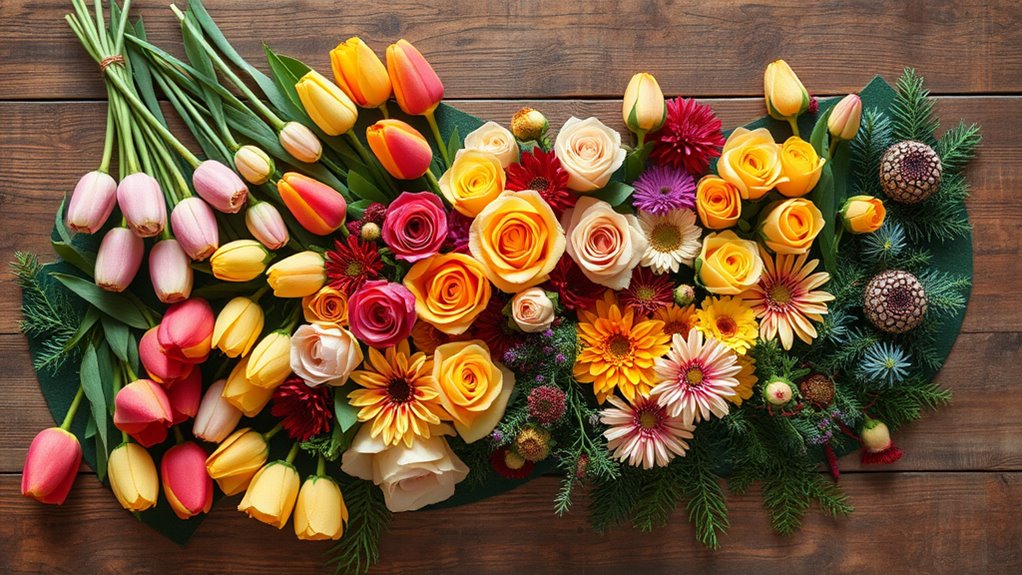The Flower Planting Calendar Every Gardener Needs
You’ll build a thriving garden year-round with this precise flower planting calendar. In spring, plant cool-season varieties like pansies and tulips after testing soil pH and adding compost for strong roots. For summer, choose heat-tolerant zinnias and sunflowers, deadheading weekly to extend blooms. Autumn calls for hardy chrysanthemums with soil amendments to avoid frosts. Prepare winter beds with mulch and frost protection for resilient plants. Explore perennials for longevity and annuals for vibrant displays, where further insights await.
Spring Planting Guide
As spring unfolds, you can kick off your flower planting by focusing on cool-season varieties like pansies and tulips, which thrive in temperatures between 40°F and 60°F for ideal root development and vibrant blooms.
Incorporate seasonal flower planting by testing soil pH, adding compost, and planting in well-drained areas. Additionally, consider including best spring plants such as snapdragons and violas to enhance your garden’s color and variety.
Always mulch for moisture retention and watch for frosts to safeguard your blooms.
Summer Flower Selections
With summer’s arrival, you select heat-tolerant flowers like zinnias and sunflowers that flourish in temperatures above 70°F, demanding full sun and regular watering to promote strong growth and colorful displays.
You’ll also choose cosmos for drought resistance, deadhead blooms weekly to extend flowering, apply mulch for moisture retention, and monitor for pests like aphids to maintain vibrant, healthy plants. Additionally, consider incorporating seasonal gardening tips to ensure a diverse array of blooms throughout the summer.
Autumn Planting Strategies
As you select autumn flowers like chrysanthemums or pansies that tolerate cooler temperatures, you guarantee your garden thrives through the fall.
You prepare the soil by testing its pH and amending it with organic matter for better drainage and nutrients. Additionally, conducting a nutrient assessment will help you understand what specific amendments your soil may need to promote healthy plant growth.
You time your planting in early autumn to avoid early frosts and maximize root establishment.
Select Autumn Flowers
Select autumn flowers that thrive in cooler temperatures and offer vibrant colors for your fall garden.
You’ll make smarter choices by evaluating these factors for best results:
- Hardiness Rating: Pick flowers like mums suited to your USDA zone, ensuring they endure autumn’s dropping temperatures without damage.
- Bloom Period: Choose varieties such as asters that extend flowering into late fall, maximizing seasonal vibrancy.
- Pollinator Value: Select species like sedum that support bees, fostering a balanced ecosystem in your space.
Prepare the Soil
Prepare your soil for autumn planting by first testing its pH and nutrient levels, as this helps you adjust conditions to suit hardy fall flowers.
If imbalances appear, amend with lime to raise pH or sulfur to lower it.
Incorporate organic compost for improved fertility and structure.
Till gently to aerate and enhance drainage, promoting robust root growth without compaction.
Time Your Planting
With your soil now prepped, you’ll determine the ideal planting times for autumn flowers by checking your local frost dates and selecting varieties that match the season’s shortening days.
For effective autumn strategies, implement these key practices:
- Choose hardy varieties suited to your USDA zone to withstand cooling temperatures.
- Time planting 2-4 weeks before the first frost for strong root development.
- Monitor weather patterns to adjust for sudden changes, ensuring plant resilience.
Winter Preparation Essentials
As winter approaches, you’ll safeguard your flower beds by prioritizing frost protection and soil insulation.
Apply organic mulch layers, like straw or bark, to maintain even soil temperatures and reduce heaving.
Cover vulnerable plants with breathable fabrics to minimize freeze-thaw cycles.
Test soil pH and amend with compost for nutrient retention, promoting robust root health through cold months. Additionally, consider using innovative mulching techniques to enhance moisture retention and prevent weed growth.
Perennial Favorites for Longevity
Perennials like peonies and hostas deliver lasting garden value, returning reliably each year with proper care.
You’ll achieve this by focusing on these essential practices:
- Select perennials suited to your zone and soil to assure survival against local conditions.
- Plant them at the correct depth and spacing for robust root establishment and growth.
- Maintain routine care, including watering and dividing, to prevent decline and extend lifespan. Additionally, choosing vibrant flower varieties can enhance the overall beauty of your garden throughout the seasons.
Annual Varieties for Vibrant Displays
Annual flowers deliver vibrant, seasonal color to your garden, completing their life cycle in one year to refresh displays effortlessly.
You’ll select resilient varieties like zinnias and marigolds, which thrive in full sun and well-drained soil.
Plant seeds after the last frost, space them 6-12 inches apart, water consistently, and deadhead blooms to extend flowering, ensuring a practical, eye-catching show all season.

